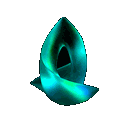
Circle of Life – Glass Sculpture in Dialogue with Light and Space
Created in collaboration with the renowned Lhotsky Studios, Cycle of Life translates my sculptural language into the medium of glass. In dialogue with light, the work unfolds a living presence: reflective, translucent, and constantly in motion – radiating from its core
Circle of Life is a stand-alone sculpture first conceived for outdoor installation, is a sculptural base for galleries and public spaces as well as part of curated installations.
Thomas Doerr – Circle of Life – 2022
Cast Lead Glass, 30 × 18 x 16 cm — foundation of multimedia and lenticular art, symbol of eternal life
 |  |  |
|---|---|---|
 |
Rooted in my triangular ceramic models, this glass work carries forward the idea of tension, balance, and resolution into another material. The triangle, as a symbol of harmony, remains a guiding principle – visible in structure, perceptible in its effect.
The production was realized in close collaboration with the internationally acclaimed Zdeněk Lhotský, a leader in cast glass arts and workmanship. Interesting technical insights into the behavior and prediction of cast glass can be found in the doctoral research of Dr. Dr Heike Brachlow (University of Wolverhampton).
Circle of Life first target is an outdoor installation – a sculpture that changes with daylight, the sun’s position, and the rhythm of the seasons. It becomes part of its environment: at times transparent, at times radiant, at times enigmatic.

It creates a space that is both monumental and fragile, an experiential field between nature and art. A decent kaleidoscopic night illumination makes it a full day performance.
Thomas Doerr – Triangola Edition O – 2022
Cast Lead Glass, 30 × 18 x 16 cm — Circle of Life in dialogue with nature — a poetic interplay of sun, seasons and the night’s gentle glow.


